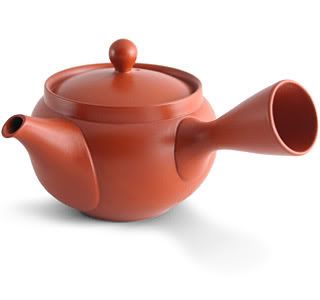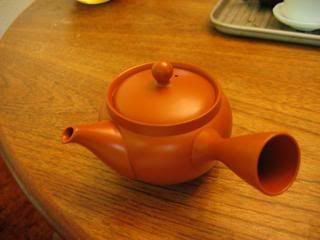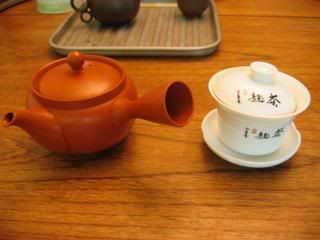
For a long time now I have been enjoying Japanese greens. My favorite of which is Sencha. I will admit that I enjoy Gyokuro more, but Gyokuro is so expensive that it's not a practical tea to drink. The lower price of Sencha allows me to enjoy it more often and to entertain my palate with a wider variety of such greens.
When I first started drinking Sencha, I would use a glass infuser to prepare it. After a few months of tea-drinking, I found that Sencha was the tea I drank the most. When I realized this, I also realized that I should get more serious about my Sencha drinking by buying a teapot made especially for Sencha. I looked through over 50 teapots before deciding on Rishi Tea's Fukugata. I decided on the Fukugata because of it's low price, smooth and elegant style, and the fact that many tea-enthusiasts have the same pot and are quite happy with it.
After 9 days and a UPS reschedule, the pot arrived, packed with an abundance of protection (as shown in the last post).


Upon examination, I was hit by it's perfection through simplicity. The spout and the handle, by no means intricate, are flawlessly crafted to the body, exhibiting nothing but the intention of use.

A pot made to be used. I felt a sudden dire need to pour out cup after cup of air:


The lid was even more delightful, fitting as snuggly as possible into it's proper place.


With the lid off, the sasame is exposed:

The sasame (clay filter) is of much importance when brewing Senchas. This is because Senchas are very often composed of small pieces that need to get filtered out. Typically, the best filter is a stainless steel mesh screen, traditionally however, the filters are made of clay, and known as sasame. These clay sasame are preferred by many who believe metal to affect the taste of Sencha. This is why very serious Sencha drinkers also boil their water in a clay pot as opposed to a metal pot.


As can be seen in the pictures, the sasame is riddled with small holes. At first I gleefully cheered at such fine work, however I then realized (after touching it a little too roughly), that this had also made it moderately fragile. Now luckily nothing that is ever placed in a teapot (tea and water) will ever damage it. I will, however, have to watch my own fingers If I ever feel the need to "investigate."
The only real problem with the sasame is with the tea leaves that get stuck in it. So far there are about 6 leaves stuck in random holes. I could very carefully poke them through, but this would risk breaking the sasame. For now, my plan is to wait it out and determine whether the holes will eventually all be filled, or if it will stay around a constant 6 holes.
At 300ml it is a bit larger than most other asian teapots, and quite a bit larger than my gaiwan:



The feel of the Fukugata is perfect. The side-handle provides a solid grip on a light pot that allows for easy pouring.

With the tight-fitting lid, I can flip the teapot 90° with no fear of spilling (as long as a slight thumb is applied).
To be used for comparison purposes, I decided on Adagio's Sencha Overture. It was a good pick because Sencha overture is between a "good" sencha and a "bad" sencha. Being closer to "bad" allows easy determination of when a process has improved the quality of the tea.



I decided on one steeping in the gaiwan, and one steeping in the Fukugata, fresh tea leaves in each.

Notice the amount of leaves used.

The amount of leaves is roughly proportionate to the amount of water to be used.
85 seconds with just under 180° water for each.
Gaiwan brewed tea:

And the following are the Fukugata brewed teas:

Notice how these...

Compare to this:

The second picture here shows an obviously darker brew, yet all the tea shown in these images was from the same pot/steeping.


The darker tea actually was the last from the pot and is to be expected because of the components that color tea often sit near the leaves. Thus pouring out of the pot last. Since the gaiwan brewed tea was all poured into a single vessel, this was not noted.
Here the gaiwan brew is in the middle:

I then combined the tea from all the vessels holding the fukugata brewed tea into a single vessel (gaiwan brewed tea is in the cup):

Gaiwan brewed tea in cup on right, Fukugata brewed tea in cup on left:

Birdseye view:

Although much harder to distinguish, the Fukugata brewed tea is still a might bit darker.
Differences in temperature interfered greatly in the tea-tasting comparison. As such, none of my notes are definite differences.
What I did note as a near-definite difference was that the Fukugata brewed a tea that was more "vegetal" while tasting cleaner, and airy. The flavor of the tea from the gaiwan leaned more towards "grassy" carrying with it a peck of astringency and an undertone of a grahammy-bite.
These differences are not at all extreme, and are describing a roughly 5% difference between the teas.
In summary, the Fukugata is a solidly constructed pot, lacking in durability only by having a somewhat fragile sasame (clay filiter). The many holes of the sasame also allow for tea leaves to get stuck, which is expected, yet the fragility of the sasame make it a difficult and careful job to remove such leaves.
The handling of the Fukugata during use was extremely pleasing. The handle is long and thin, which helps it to keep cool, yet is also firm and durable. The lid fits very snugly, allowing the pot to be turned 90°(as long as a thumb is reasonable applied to the ever-cool ball on top). The fukugata's capacity (10oz) allows it to brew a larger cup of tea than the average asian teapot, yet for cases such as gongfu brewing, will require greater precision and more spacious equipment.
While not being intricately designed, the Fukugata still holds beauty in its simplicity.
My conclusion is that the Fukugata is a wonderful purchase. For the price ($35 from Rishi-Tea), I do not believe one can find a better pot. Although I have no experience of other pots of it's kind, I strongly recommend the Fukugata over other Japanese teapots in it's price range. It has proven to be a solid, well put together pot whose spirit begs for it to be put to use.



2 comments:
Wow, Wes--a very thorough review! I hadn't thought about comparing a sencha brewed in my kyusu vs. another method. I might just have to steal your idea.
Thanks for taking the time to post this. Quite enjoyable. I just saw this pot at a shop today.
Post a Comment